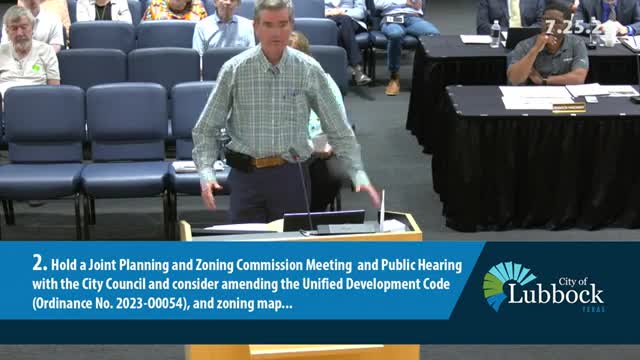City leaders clash over new development restrictions
July 26, 2024 | Lubbock, Lubbock County, Texas

This article was created by AI summarizing key points discussed. AI makes mistakes, so for full details and context, please refer to the video of the full meeting. Please report any errors so we can fix them. Report an error »

In a recent government meeting, significant concerns were raised regarding new setback requirements that have drastically altered land use regulations for commercial and industrial development. The front setback has increased from 10 feet to 40 feet, while the rear setback has expanded from zero to 100 feet. Additionally, side setbacks have been introduced at 20 feet, and sign setbacks have doubled from 10 feet to 20 feet. These changes have been described as \"a big difference\" that severely restricts land use and could deter development within city limits.
A representative highlighted the impact of these regulations, citing a case study where a project lost 3,700 square feet of building space and faced increased parking requirements. The speaker argued that such restrictions not only diminish the value of land but also reduce the city's tax base, as less development translates to fewer properties contributing to local revenue. The representative urged city officials to reconsider these regulations, emphasizing the need for a more conducive environment for development to prevent projects from moving to neighboring Lubbock County.
City officials acknowledged the importance of collaboration with developers, recognizing their role as partners in the community's growth. They expressed a commitment to reviewing suggestions from stakeholders to ensure that development aligns with the unique character of Lubbock. The discussion also touched on the challenges faced by city staff, who are often constrained by existing codes, underscoring the need for clearer guidelines to facilitate their work.
In a related topic, the meeting addressed the preservation of brick streets in specific areas of the city, including Broadway Avenue and downtown. The city is currently reviewing ordinances that protect these historic streets, indicating a broader commitment to maintaining Lubbock's cultural heritage while navigating the complexities of urban development.
A representative highlighted the impact of these regulations, citing a case study where a project lost 3,700 square feet of building space and faced increased parking requirements. The speaker argued that such restrictions not only diminish the value of land but also reduce the city's tax base, as less development translates to fewer properties contributing to local revenue. The representative urged city officials to reconsider these regulations, emphasizing the need for a more conducive environment for development to prevent projects from moving to neighboring Lubbock County.
City officials acknowledged the importance of collaboration with developers, recognizing their role as partners in the community's growth. They expressed a commitment to reviewing suggestions from stakeholders to ensure that development aligns with the unique character of Lubbock. The discussion also touched on the challenges faced by city staff, who are often constrained by existing codes, underscoring the need for clearer guidelines to facilitate their work.
In a related topic, the meeting addressed the preservation of brick streets in specific areas of the city, including Broadway Avenue and downtown. The city is currently reviewing ordinances that protect these historic streets, indicating a broader commitment to maintaining Lubbock's cultural heritage while navigating the complexities of urban development.
View full meeting
This article is based on a recent meeting—watch the full video and explore the complete transcript for deeper insights into the discussion.
View full meeting
